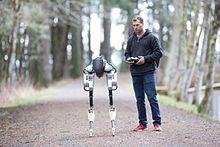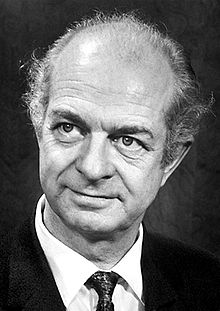Oregon State University College of Engineering
 | |
| Type | Public engineering school |
|---|---|
| Established | 1889 |
Parent institution | Oregon State University |
| Accreditation | ABET |
| Dean | Scott Ashford |
| Undergraduates | +8,500 |
| Location | , U.S. 44°34′02″N 123°16′29″W / 44.5672°N 123.2748°W |
| Colors | Orange and black[1] |
| Website | engineering |
Oregon State University's College of Engineering is the engineering college of Oregon State University, a public research university in Corvallis, Oregon. By enrollment, the college is now the largest at the university and the seventh-largest engineering college in the nation (2023).[2]

History
[edit]The college's first professorship, exclusively in engineering, was awarded to Grant Adelbert Covell in 1889. That same year, Covell founded the OSU Department of Mechanical Engineering and organized the construction of the first engineering building, Mechanical Hall. Degrees in civil engineering were awarded as early as the 1870s. The college later established departments in electrical (1897), mining (1904), and civil (1905) engineering over the college's initial 20 years. Mechanical Hall burned down during this period but was rebuilt a short time later and renamed Apperson Hall, much later, in 1920. In 1908, the college's name changed to the OSU School of Engineering. Covell served as the school's first dean.[4]
Oregon State University became the only public university in the state to offer accredited degrees in all major engineering fields. OSU was designated Oregon's engineering university by the State Board of Higher Education in 1914, with the goal of providing the university a distinct curriculum among Oregon universities.[5] Chemical engineering was incorporated into the college as a formal department in 1932, followed by industrial engineering in 1943, nuclear engineering in 1968 and computer science in 1974.
In 1955 J. Robert Oppenheimer visited the college to give two historic lectures in nuclear physics on the "Constitution of Matter".[6] The visit to the college was not without controversy. The University of Washington canceled his planned lecture at their campus due to J. Edgar Hoover's accusations Oppenheimer participated in pro-communist activities. Recordings of his two lectures at the college are now stored in Washington D.C. at the Library of Congress.[7][8]
In 2008, Apperson Hall received a major remodel and was renamed Kearney Hall.[9]
The College of Engineering claims over 35,000 graduates since its founding in 1889.[10]
Schools
[edit]- Mechanical, Industrial, and Manufacturing Engineering
- Civil and Construction Engineering
- Electrical Engineering and Computer Science
- Chemical, Biological, and Environmental Engineering
- Nuclear Science and Engineering
Enrollment
[edit]As of Fall 2022, there were over 9,800 students enrolled in the college of engineering at the Corvallis campus.[11] The college of engineering's faculty is made up of approximately 122 members whose time is split between teaching and research.[12] The college's operational budget for the 2022–2023 school year was $128.2 million with $64.6 million from research grants and $19.4 million from private donors.[13]
Computer science (CS) students set a new record in 2022. CS students were awarded more CS degrees than any other engineering college in the nation.[14]
Research
[edit]
A team of scientists from OSU's Nuclear Science and Engineering school is credited with inventing the first Small Modular Reactor (SMR) in 2007. OSU's SMR was used by NuScale Power as the prototype for the NuScale Power Module and is used within their VOYGR power plants. As of 2023, the NuScale Power Module is the only SMR approved by the Nuclear Regulatory Commission for operation in the US.[15] SMR's are designed to power individual commercial operations, rather than entire cities. The latest SMR OSU and NuScale Power developed delivers up to 50 megawatts of energy (MWe). Up to six NuScale Power Modules can be used in a single VOYGR power plant, producing up to 300 MWe. OSU and NuScale Power are working with the Nuclear Regulatory Commission to increase the output per module to 77 MWe and allow up to 12 modules in a single VOYGR powerplant for a maximum output of 924 MWe.[16]
Expansion
[edit]OSU engineering continues to expand its campus footprint to accommodate higher enrollments and the addition of new programs. A new 153,000-square-foot building was added to the campus in 2006. The Kelley Engineering Center is home to the school of electrical engineering and computer science. A major remodel was also completed to Kearney Hall in 2008. The renovation serves as home to the school of civil and construction management engineering.

College of engineering alumnus and nVIDIA founder and CEO, Jen-Hsun "Jensen" Huang, is helping to build a $200 million research and education center planned for campus. The center will be named after the alumnus and his wife, Lori Huang, who are donating $50 million to the project. The Jen-Hsun and Lori Huang Collaborative Innovation Complex (CIC) will feature a massive AI supercomputer powered by nVIDIA hardware.[17] The 150,000-square-foot center, due to open in 2025, will accelerate work at Oregon State’s top-ranked engineering programs in computer sciences, robotics, materials sciences and other programs, outside of engineering, with the help of AI.
In 2023, the campus opened Johnson Hall. The hall is the new home for the school of chemical, biological, and environmental engineering. Peter Johnson and his wife, Rosalie, both alumni of the school, sponsored the new addition with a $7 million dollar gift for its construction in 2016. The 58,000 square-foot building features an entryway plaza, modern offices, laboratory classrooms and open spaces for the school's faculty and students. Johnson invented a device and process used to manufacture longer-lasting lead-acid car batteries in 1980. He went on to found Tekmax Inc. in 1981.[18][19]
Notable alumni
[edit]
- Thomas J. Autzen, electrical engineer, co-inventor of plywood manufacturing glue-spreader.
- Richard D. Braatz, researcher in control theory and its applications, Edwin R. Gilliland professor in chemical engineering at the Massachusetts Institute of Technology.
- George Bruns, an American composer of music for film and television with four Academy Award nominations and three Grammy Award nominations.
- Randy Conrads, Classmates.com founder.
- Marion Eugene Carl, American military officer, World War II fighter ace, record-setting test pilot, and naval aviator.
- Holly Cornell, co-founder of international environmental engineering company CH2M.
- Douglas Engelbart, inventor of the computer mouse, 2000 National Medal of Technology.
- Paul Hugh Emmett, Chemical engineer who pioneered in catalysis, co-namesake of BET theory and member of the Manhattan Project.
- Dick Fosbury, best known for inventing the Fosbury flop, gold medalist in 1968 Olympics, co-owner of Galena Engineering, Inc. in Ketchum, Idaho.
- Peter Gassner, co-founder of Veeva Systems.
- Elmer E. Hall, US Marine Corps. commander of 8th Marine Regiment during the Battle of Tarawa.
- Milton Harris, founder of Harris Research Laboratories (known as Gillette today).
- Thomas Burke Hayes, co-founder of international environmental engineering company CH2M.
- James Howland, co-founder of international environmental engineering company CH2M.
- Jen-Hsun Huang, CEO/co-founder of nVIDIA Corp., National Academy of Engineering member.
- Glenn Jackson, former Oregon Transportation Commission chair and namesake of the Glenn L. Jackson Memorial Bridge.
- Timothy S. Leatherman of Leatherman Tool Group, Inc.
- Conde McCullough, known for designing many of Oregon's historic coastal bridges on U.S. Route 101.
- Roger Nichols, eight-time Grammy Award-winning recording engineer for many major musical artists of the 1970s-80s.
- William Oefelein, NASA Astronaut.
- Glenn Odekirk, Hughes Aircraft Aerospace Engineer who helped design the H-4 Hercules. He is portrayed in the 2004 movie The Aviator as "Odie".
- Hüsnü Özyeğin, founder of Finansbank in 1987 and one of Turkey's most successful bankers.
- Linus Pauling, 1954 Nobel Prize in Chemistry & 1962 Nobel Peace Prize recipient; the only person ever to win two unshared Nobel Prizes.
- Donald Pettit, NASA astronaut.
- Stephen O. Rice, pioneer in the related fields of information theory, communications theory, and telecommunications.
- Ada-Rhodes Short, mechatronic design engineer and transgender rights activist.
- Bert Sperling, author and researcher of cities.
- Frederick Steiwer, Oregon state senator, district attorney, and 1936 Republican presidential candidate.
- William Tebeau, first African-American male graduate (chemical engineering, 1948) and namesake of William Tebeau Residence Hall.
- Lee Arden Thomas, early Oregon architect known for designing landmark downtown buildings.
- Earl A. Thompson, American engineer and inventor credited with the invention of the synchromesh manual transmission in 1918.
- James K. Weatherford, Oregon attorney, judge, and state politician
- John A. Young, former CEO of Hewlett-Packard.
- Peter C. Zimmerman, Oregon state senator and advocate for independently owned farms.
Notable faculty
[edit]- Octave Levenspiel, emeritus professor of chemical engineering at Oregon State University, author of five books, and member of the National Academy of Engineering
References
[edit]- ^ "Colors | Oregon State University Relations and Marketing". July 8, 2019.
- ^ "College of Engineering Fact Sheet" (PDF). engineering.oregonstate.edu. Oregon State University. Retrieved September 27, 2022.
- ^ Lundeberg, Steve. "Bipedal robot developed at Oregon State achieves Guinness World Record in 100 meters". OSU. Retrieved November 21, 2023.
- ^ "More than a century of history…more than a century of excellence". oregonstate.edu. OSU. Retrieved May 12, 2024.
- ^ Groshong, James W. "The Making of a University – Oregon State University". oregonstate.edu. Oregon State University. Retrieved September 11, 2022.
- ^ ""Condon lecture at Oregon State College". researchworks.oclc.org". researchworks.oclc.org. Washington, D.C. : Library of Congress. Retrieved February 23, 2024.
- ^ "The constitution of matter". University of Chicago. Retrieved February 24, 2024.
- ^ Oppenheimer, J. Robert. "The Constitution of Matter - Transcript of OSU Lecture". uchicago.edu/. Oregon State System of Higher Education. Retrieved April 6, 2024.
- ^ "More than a century of history…more than a century of excellence". oregonstate.edu. OSU. Retrieved May 12, 2024.
- ^ "Fact Sheet". oregonstate.edu. Oregon State University. Retrieved March 3, 2022.
- ^ "College of Engineering Fact Sheet". engineering.oregonstate.edu. Oregon State University. Retrieved September 27, 2022.
- ^ "College of Engineering Fact Sheet". engineering.oregonstate.edu. Oregon State University. Retrieved September 27, 2022.
- ^ "College of Engineering Fact Sheet". engineering.oregonstate.edu. Oregon State University. Retrieved September 27, 2022.
- ^ "College of Engineering Fact Sheet" (PDF). engineering.oregonstate.edu. Oregon State University. Retrieved September 27, 2022.
- ^ "Oregon Company Tied to OSU Invents Small Nuclear Reactor". oregon.arcsfoundation.org. ARC Foundation. Retrieved December 18, 2023.
- ^ Burnell, Scott. "NRC to Begin Reviewing Portions of NuScale's Small Modular Reactor Standard Design Approval Application" (PDF). nrc.gov. Nuclear Regulatory Commission. Retrieved December 18, 2023.
- ^ Peckham, Oliver (October 17, 2022). "Oregon State University to Launch Nvidia-Powered Supercomputer Center". hpcwire.com. Tabor Communications. Retrieved November 24, 2022.
- ^ Hautula, Keith. "n Memoriam: Peter Johnson". alumnimag.engineering.oregonstate.edu. OSU. Retrieved March 5, 2023.
- ^ "Creating a Campus Hub". srgpartnership.com. SRG Partnership Inc. Retrieved March 5, 2023.
